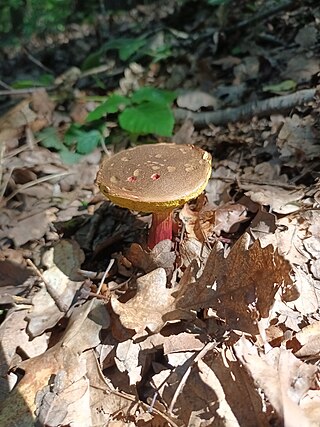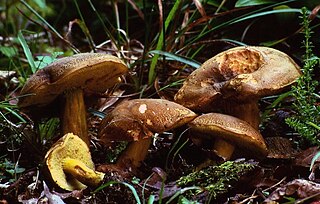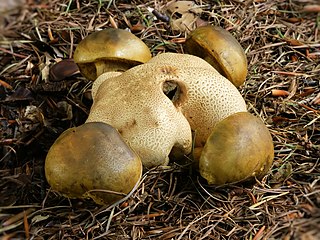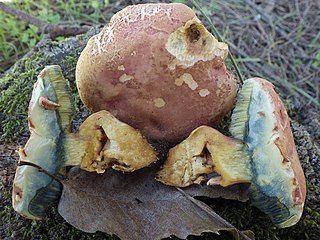Related Research Articles

Xerocomus is a genus of poroid fungi related to Boletus. Many mycologists did not originally recognize the distinction between the two genera and placed Xerocomus taxa in genus Boletus. However, several molecular phylogenetic studies have demonstrated that Xerocomus is a heterogeneous genus of polyphyletic origin, which has resulted in further division of Xerocomus into Xerocomellus and Hemileccinum. The members of the genus Xerocomellus are more closely related to Boletus than true Xerocomus is, which is relatively distantly related to Boletus and more closely related to Phylloporus. Other former Xerocomus species have since been moved to Aureoboletus, Imleria, Hortiboletus and Rheubarbariboletus.

Xerocomellus chrysenteron, formerly known as Boletus chrysenteron or Xerocomus chrysenteron, is a small, edible, wild mushroom in the family Boletaceae. These mushrooms have tubes and pores instead of gills beneath their caps. It is commonly known as the red cracking bolete.

Hortiboletus rubellus, commonly known as the ruby bolete, is a small, dainty, brightly coloured member of the family Boletaceae, with a reddish cap and stipe, and yellow pores. Like many boletes, it stains blue when cut or bruised. It is found in deciduous woodland in autumn. There is some question over its edibility, and it is reportedly of poor quality with a taste of soap. Until 2015, the species was known as Boletus rubellus.

Xerocomus subtomentosus, commonly known as suede bolete, brown and yellow bolete , boring brown bolete or yellow-cracked bolete, is a species of bolete fungus in the family Boletaceae. The fungus was initially described by Carl Linnaeus in 1753 and known for many years as Boletus subtomentosus. It is edible, though not as highly regarded as other bolete mushrooms.

Xerocomellus porosporus is a small wild mushroom in the family Boletaceae. These mushrooms have tubes and pores instead of gills beneath their caps. It is commonly known as the sepia bolete.
Xerocomus silwoodensis is a species of bolete fungus first described in 2007. It was discovered by scientists on Silwood Campus, Imperial College, London and was named after this accordingly. Its discovery on a campus of a leading academic institution has been used to show how little is known about many species. Its discovery was rated as the seventh-best discovery of a new species in 2008 by the International Institute for Species Exploration. It has since been found at two other sites in the United Kingdom and also in France and Italy. It has therefore been asserted that it is a widespread but rare species.

Bothia is a fungal genus in the family Boletaceae. A monotypic genus, it contains the single species Bothia castanella, a bolete mushroom first described scientifically in 1900 from collections made in New Jersey. Found in the eastern United States, Costa Rica, China, and Taiwan, it grows in a mycorrhizal association with oak trees. Its fruit body is chestnut brown, the cap is smooth and dry, and the underside of the cap has radially elongated tubes. The spore deposit is yellow-brown. The edibility of the mushroom is unknown. Historically, its unique combination of morphological features resulted in the transfer of B. castanella to six different Boletaceae genera. Molecular phylogenetic analysis, published in 2007, demonstrated that the species was genetically unique enough to warrant placement in its own genus.

Pseudoboletus parasiticus, previously known as Boletus parasiticus and Xerocomus parasiticus, and commonly known as the parasitic bolete, is a rare Boletaceae mushroom found on earthballs. Pseudoboletus parasiticus is one of the earliest-diverging lineages of the Boletaceae, after the clade comprising Chalciporus and Buchwaldoboletus.
Xerocomus belizensis is a species of bolete fungus in the family Boletaceae. Found in Belize, it was described as new to science in 2007.

Xerocomus illudens is a species of bolete fungus in the family Boletaceae. Described as new to science in 1898, it is found in Asia and North America, where it grows in a mycorrhizal association with oak.

Boletus miniato-olivaceus is a species of bolete fungus in the family Boletaceae. Described as new to science in 1874, it is found in eastern North America and northeast Mexico.

Xerocomellus is a genus of fungi in the family Boletaceae. The genus, as it was described in 2008, contained 12 species. However X. rubellus and X. engelii were transferred to the new genus Hortiboletus and X. armeniacus was transferred to the new genus Rheubarbariboletus in 2015. Molecular analysis supports the distinction of Xerocomellus species from Boletus and Xerocomus, within which these species were formerly contained. Xerocomellus in fact is only distantly related to Xerocomus and is most closely related to Tylopilus, Boletus sensu stricto, Porphyrellus, Strobilomyces, and Xanthoconium.

Hemileccinum is a genus of fungi in the family Boletaceae. It was erected in 2008 by Josef Šutara to contain two species united by a number of shared morphological features: H. depilatum and the type H. impolitum. In 2014, Wu et al. found it to be distinct from other bolete genera in a molecular phylogenetic study and found it to be most closely related to Corneroboletus. In 2015, H. subglabripes was transferred to Hemileccinum from Boletus based on DNA evidence, while subsequent studies further confirmed the monophyly of the genus.

Xerocomellus pruinatus, commonly known as the matte bolete and formerly known as Boletus pruinatus or Xerocomus pruinatus, is a mushroom in the family Boletaceae native to Europe.

Hemileccinum impolitum is a basidiomycete fungus of the family Boletaceae, native to Europe. It is commonly referred to as the iodine bolete, because its fruit bodies tend to emit an iodine odour when cut, more detectable in the stem base or overripe specimens.

Hortiboletus bubalinus is a species of bolete fungus in the family Boletaceae. Originally described in 1991 as a species of Boletus, the fungus was transferred to Xerocomus in 1993. It was transferred to Hortiboletus by Bálint Dima in 2015.

Imleria badia, commonly known as the bay bolete, is an edible, pored mushroom found in Eurasia and North America, where it grows in coniferous or mixed woods on the ground or on decaying tree stumps, sometimes in prolific numbers. Both the common and scientific names refer to the bay- or chestnut-coloured cap, which is almost spherical in young specimens before broadening and flattening out to a diameter up to 15 cm (6 in). On the cap underside are small yellowish pores that turn dull blue-grey when bruised. The smooth, cylindrical stipe, measuring 4–9 cm long by 1–2 cm thick, is coloured like the cap, but paler. Some varieties have been described from eastern North America, differing from the main type in both macroscopic and microscopic morphology.

Rheubarbariboletus persicolor is a species of bolete fungus. It was originally described in 1996 as Xerocomus persicolor, based on collections made in Italy. The bolete was found in mixed woodland with hop-hornbeam, pine, and oak.
References
- ↑ Ortiz-Santana B, Lodge DJ, Baroni TJ, Both EE (2007). "Boletes from Belize and the Dominican Republic" (PDF). Fungal Diversity. 27: 247–416 (see p. 382).